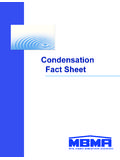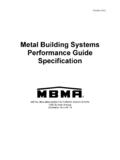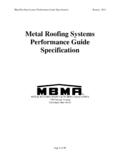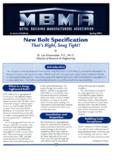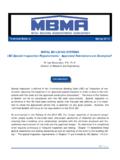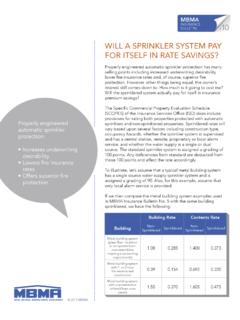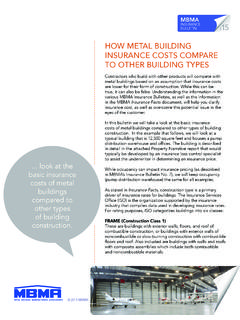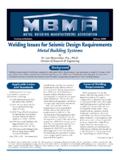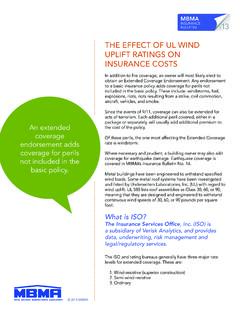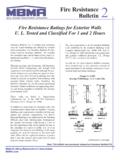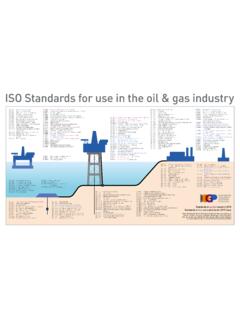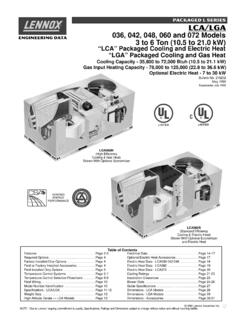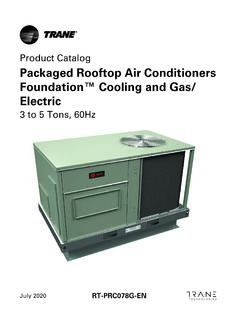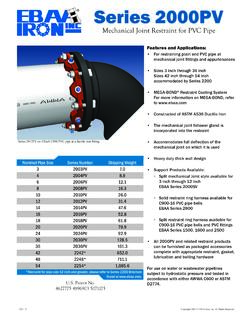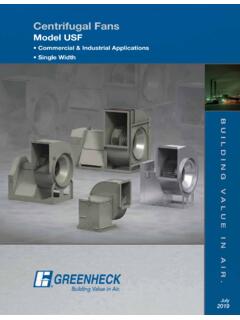Transcription of Condensation Fact Sheet - MBMA
1 Condensation Fact SheetME TA L B U I L D I N G MA N U FAC T U R E R S A S S O C I AT I O NThe Condensation ProcessCondensation occurs when warmer moist air comes in contact with cold surfaces such as framing members, windows and other accessories, or the colder region within the insulation envelope (if moisture has penetrated the vapor retarder). Warm air, having the ability to contain more moisture than cold air, loses that ability when it comes in contact with cool or cold surfaces or regions. When that happens, excessive moisture in the air is released in the form of Condensation . In metal buildings, there are two possible consequences of trapped moisture in wall and roof systems: (1) corrosion of metal components and (2) degradation of the thermal performance of Point and Relative HumidityDew point is the temperature at which water vapor in any static or moving air column will condense into water. In other words, the air is saturated and can no longer hold the moisture at this temperature.
2 When the air temperature drops below its dew point, excess moisture will be released in the form of Condensation . Condensation problems are most likely to occur in climates where temperatures frequently dip to 35 F or colder over an extended period of humidity is a percentage measurement of the amount of water vapor present in the air in relation to the amount it is capable of holding at that temperature. For example, 50% relative humidity indicates the air is carrying one-half of the maximum amount of moisture that it is capable of containing at the given temperature. There is a relationship between the dew point and relative humidity. A high relative humidity means that the dew point is near the current air temperature. Therefore, a relative humidity of 100% indicates that the dew point is equal to the current temperature. This relationship between dew point and relative humidity is given in Table and Concealed CondensationTwo things must be present for Condensation to occur: warm moist air, and cool surface temperatures below the dew point.
3 The proper control of these two factors can minimize metal building systems, we are concerned with two different areas or locations: visible Condensation which occurs on surfaces below dew point temperatures; and concealed Condensation which occurs when moisture has passed into interior regions and then condenses on a surface that is below the dew point of visible surface Condensation are water, frost or ice on windows, doors, frames, ceilings, walls, floor, insulation vapor retarders, skylights, cold water pipes and/or cooling ducts. To effectively control visible Condensation , it is necessary to reduce the cold surface areas where Condensation may occur. It is also important to minimize the air moisture content within a building by the use of properly designed ventilating of concealed Condensation include damp spots, stains, mold and/or mildew on walls or ceilings, delamination of laminated surfaces, bubbles or blisters in asphaltic surfaces, peeling paint, and damp insulation.
4 Concealed Condensation is the most difficult to deal with and can be the most damaging. This type of Condensation may be controlled in metal buildings by the proper use of vapor retarders and by minimizing moisture content within the building by proper ventilation. Additional Condensation control can be accomplished by venting the cavities of the walls and roof. Vapor RetardersA vapor retarder is used to inhibit the passage of warmer moist air into the inner regions of the roof or wall system. The proper selection and installation of the vapor retarder can help control Condensation problems in a building. Vapor retarders are rated by the amount of moisture that can pass through them. The lower this rating, called a perm rating, the less vapor transmission will occur and the more effective the vapor retarder will be. Water vapor transmission rates (perms) are determined using ASTM E 96, Standard Test Methods for Water Vapor Transmission of Materials (ASTM, 2005).Types of Vapor RetardersThere are various types of vapor retarders available, such as:1.
5 Structural membranes, including rigid steel sheets or other Dew Point Temperature (oF)1 RelativeHumidityDesign Dry Bulb (Interior) Temperature32oF35oF40oF45oF50oF55oF60oF6 5oF70oF75oF80oF85oF90oF95oF100oF100%3235 40455055606570758085909510090%3033374247 5257626772778287929780%27303439444954586 468737883889370%242731364045505560646974 79848860%2024283236414651556065697479835 0%16202428333641465055606469737840%12151 823273135404549535862677130%810141621252 9333742465054596220%67891316202428313540 43485210%445568910131720242730341 Chart adapted from ASHRAE Psychometric Chart, 2005 ASHRAE Handbook of FundamentalsTable C-1: Dew Point Temperature (oF)1 verses Relative Humidityimpermeable materials. The list below is not exhaustive, nor is it an effort to limit the designer, but these membranes may include the following in roof and/or wall construction: a. Steel formed panels, properly sealed on edges and ends. b. Steel, zinc alloy, copper or aluminum sheets with caulked and formed standing seam edges and ends.
6 C. Vinyl siding applied to suitable structural substrate or sheathing. d. Tilt-up concrete panels, suitably sealed at end and side laps, with a painted exterior. e. Vinyl, metalized plastic and similar overlays on rigid board insulation. f. Foam insulated metal panels, caulked and sealed at ends and side laps. g. Bituminous spray or trowel-on coating on concrete or Flexible membranes, such as foils, coated papers, or plastic films. Usually, these membranes are rated by perm of or less, per ASTM E 96, Standard Test Methods for Water Vapor Transmission of Materials (ASTM, 2005). The most common applications for metal buildings are membrane retarders laminated to fiber glass blanket insulation. Plain white vinyl with a perm rating of is not an effective vapor retarder, especially in buildings with a high relative coating membranes, which includes paints, trowel-on bituminous coatings, epoxy and urethane facings for fiber glass batts serve several purposes other than appearance.
7 They prevent the blanket from sagging. They prevent most water vapor from penetrating the fiber glass batt. They provide resistance to impact and provide reflectivity and emissivity benefits. Most facings have three parts: 1. A base made up of natural or white kraft paper or aluminum foil. 2. A fiber glass scrim netting is provided for reinforcing and sag prevention. 3. An exterior film made up of polypropylene, vinyl, metalized polyester, or aluminum foil is applied on C-2 lists some of the most popular types of facings and shows their water vapor transmission rates (perm ratings). The North American Insulation Manufacturers Association (NAIMA) recommends that metal building insulation be faced with a vapor retarder having a permeance of not greater than the most popular facings, the industry provides special facings that have high impact resistance for gymnasiums, facings for high UV applications and black colored facings for structures where ceilings are not Vapor RetardersCareful attention must be paid to the insulation seams at side and end-laps to maintain the integrity of the vapor retarder.
8 Some common methods used to seal the seams include rolling and stapling the side-laps, peel and stick tabs at side-laps, and sometimes insulation tape. The use of insulation tape alone to seal the seams may not be advisable. Job site conditions such as humidity, dirt, and access to the underside of the insulation can make this difficult. Where used, tape should be at least the same quality as the vapor retarder, and the tape should be approved by the insulation supplier for the particular product. In the case of a membrane type retarder, any punctures or tears in the material should be repaired using the self-adhesive repair tape supplied with the insulation. More information and downloadable literature can be found on the NAIMA website via ,or visit National Insulation Association (NIA) there is a growing trend to add insulation to existing metal buildings, a proper vapor retarder is of critical concern. One of the most common methods is to add an additional layer of insulation to the bottom flange of the purlin system.
9 This can create an air space where moisture laden air can accumulate if the integrity of the new vapor retarder closest to the warm insulating surface of the building has not been maintained. It is important that an intact vapor retarder is not left within the insulation metal buildings require some level of ventilation, and more often this ventilation is becoming the responsibility of the metal building contractor. A lack of ventilation can create an uncomfortable working condition through elevated heat levels, excessive humidity, and stale air. It can also contribute to Condensation problems. Ventilation can best be represented by the number of times per hour the building air is replaced with outside air. This is referred to as air changes per hour. The number of air changes required per hour widely varies per following example illustrates a calculation for ventilation requirements:Facing DescriptionPermDetailsWhite vinyl economical, but not an effective vapor retarderPolypropylene scrim or metalized polypropylene, fiber glass reinforcing, 11-30 lbs white kraftPolypropylene scrim polyester, 14 lb kraftFoil scrim foil, fiber glass reinforcing, 30 lb kraftVinyl reinforced C-2: Water Vapor Transmission RatesAssume a 100 feet wide x 250 feet long x 30 feet high building being used for light manufacturing, assembly and storage.
10 1. Determine the total volume of the building. Volume = 100 feet wide x 250 feet long x 30 feet high = 750,000 ft3. 2. Next, determine the required air flow in cubic feet per minute (CFM) to provide 5 air changes per hour. Air Flow = 750,000 ft3 x 5 air changes/60 minutes = 62,500 CFM Therefore, 62,500 cubic feet per minute of air must be moved through this building to provide five air changes every hour. Allowances must be made for a place for air to enter the building and for air to exit the building, and the airflow must be evenly distributed throughout the building. Typical methods of moving air include exhaust and supply air fans, ridge ventilators and CondensationTable C-3 provides guidance on controlling Condensation problems as listed in this section. Note that all listed control measures do not address the possibility of a leak defect through the roof membrane. This is a general checklist to control Condensation through possible remedial measures. It is not designed to address specific difficulties in specific At the Source - Limit the amount of water vapor within the heated interior.
